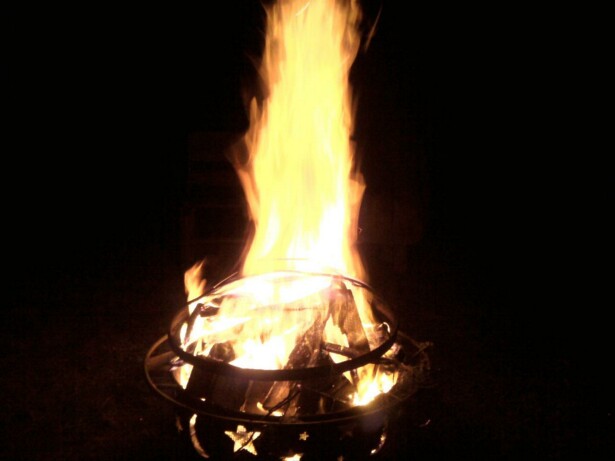|
Follow Chesha Cat's board Vikings Runes Norse on Pinterest.
| the Norns |
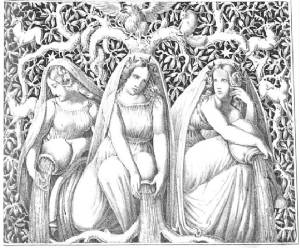
|
| Wikipedia |
"Modracu, So, Weormynd"
(Courage, Truth, Honour)
In Iceland, Spirits are in the Material World
Many on island nation believe in other-worldly beings
HAFNARFJORDUR, Iceland -- This can be a tough country for blasting out a foundation or building a roadbed.
Never mind the boiling geysers, wind-blasted precipices or frozen barrens.
It's not the razor-sharp lava rock that daunts builders; it's the hidden people lurking below.
"There are all sorts of beings beneath our stones," said Brynjolfur Snorrason,
a folklorist often asked to advise contractors on how best to avoid the lairs of Iceland's elves and other seldom-seen creatures
whose presence nonetheless still seems to permeate this far northern island nation. -- Read the rest of the article in the Archive
November 5, 2003 COPENHAGEN, Denmark (AP) -- Home to the Vikings of yore, Denmark said Wednesday it will let a group that worships Thor,
Odin and other Norse gods conduct legally-recognized marriages.
"To me, it would be wrong if the indigenous religion of this country
wasn't recognized," Tove Fergo, the minister for Ecclesiastic Affairs and a Lutheran priest, told The Associated Press.
Under Danish law, the state Evangelical Lutheran Church has sole authority
to recognize other religious communities.
The 240-member Forn Sidr, which worships Odin, Thor, Freya and the other members of the Norse pantheon, sought recognition in 1999, said Tissel Jacobsen,
the group's president.
Last year, an Ecclesiastic Affairs panel of scholars recommended that
Forn Sidr, whose name mean "Old Custom" in old Norse, be approved, but only if their rituals were clearly detailed in its
bylaws.
"At a general assembly, we added and described our four annual heathen
rituals -- spring and fall equinoxes, and the summer and winter solstices, and our marriage ceremony," Jacobsen told the AP.
"We then returned our application and the panel approved it."
Fergo said she would give her final approval "in a few days."
About 1,000 people worship the ancient gods in Denmark, Jacobsen said.
Since 1998, the panel of theology, law and history scholars have advised
the government on which groups seeking to become religious communities, should be recognized.
"It was not up to me to evaluate whether they are telling the truth or
the quality of their religion," Fergo said. "Based on the commission's evaluation and what I have read, I consider it a good
religion."
Officially recognized religious communities can marry people and exempt
their members from the 1 percent income tax that is imposed on members of the state church.
People born in Denmark are automatically made members of the state church,
but can choose to leave it if they want. Members of other recognized religious communities, such Catholics, Muslims and Jews,
are also exempt from the tax. -- Original article by JAN M. OLSEN,
Associated Press Writer, online at the San Francisco Gate
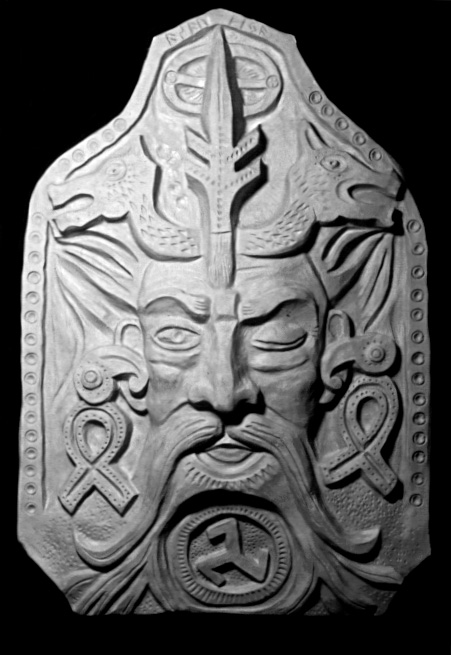
Original sculpture by Markus Wolff available for purchase
Denmark to Accept Norse God Marriages
November 5, 2003 COPENHAGEN, Denmark -- Home to the Vikings of yore, Denmark said Wednesday it will let a group that worships Thor, Odin and other Norse gods
conduct legally-recognized marriages.
"To me, it would be wrong if the indigenous religion of this country wasn't recognized,''
Tove Fergo, the minister for Ecclesiastic Affairs and a Lutheran priest, told The Associated Press. Under Danish law, the
state Evangelical Lutheran Church has sole authority to recognize other religious communities. The 240-member Forn Sidr, which
worships Odin, Thor, Freya, and the other members of the Norse pantheon, sought recognition in 1999, said Tissel Jacobsen,
the group's president. Last year, an Ecclesiastic Affairs panel of scholars recommended that Forn Sidr, whose name mean "Old
Custom'' in old Norse, be approved, but only if their rituals were clearly detailed in its bylaws.
"At a general assembly,
we added and described our four annual heathen
rituals - spring and fall equinoxes, and the summer and winter solstices,
and our marriage ceremony,'' Jacobsen told the AP. "We then returned our application and the panel approved it.''
Fergo
said she would give her final approval "in a few days.''
About 1,000 people worship the ancient gods in Denmark, Jacobsen
said. Since 1998, the panel of theology, law and history scholars have advised the government on which groups seeking to become
religious communities, should be recognized.
"It was not up to me to evaluate whether they are telling the truth or
the quality of their religion,'' Fergo said. "Based on the commission's evaluation and what I have read, I consider it a good
religion.''
Officially recognized religious communities can marry people and exempt their members from the 1 percent
income tax that is imposed on members of the state church. People born in Denmark are automatically made members of the state
church, but can choose to leave it if they want. Members of other recognized religious communities, such Catholics, Muslims
and Jews, are also exempt from the tax. -- By Jan M. Olsen for the
Associated Press, as posted to Witches With
Brains

What it means to be a warrior --
it is not merely an achievement. It is a task that must be undertaken again every day, every hour, every minute. It takes
great strength and determination to gain the self-discipline of a warrior, but without the guidance of a moral code, strength
is impotent and determination can gain nothing. Review the Nine Charges and the Nine Noble Virtues atd this page.
Other Resources:
Asatru Information Page An excellent site offering information on basic spirituality,
core texts, specialized articles, and creative writing by heathens. Also offers recipes for making mead! Mmmm!
Our Troth Members of the Ring of Troth have created an online copy of the handbook of
the Ring of Troth. This long work contains a great deal of information about the Northern Gods and Asatru.
Nine Worlds of Norse Mythology: The mythology of Asatru exists in a large realm of nine worlds, one
of which contains the land of mankind. The landscape is not that complicated once you know what the nine worlds are, and who
lives in each one.
The Runes of the Elder Futhark The runes were a gift from Odin, who gained knowledge of them during
his ordeal hanging from the world tree for nine days. His shamanic self-sacrifice obtained for mankind a wonderful divinatory
tool, as well as items that are wonderful tools for contemplation and understanding of the world.
All pagans are not pacifists -- many are warriors, who consider combat
service an important part of spiritual duty. Many pagans went to war in Iraq, and many are still members of the armed
forces and serving their countries domestically or in foreign countries.
Asatru in Argentina
Keeping Our Ancestors' Faith Alive!
Now, why this revival of the Old True Faith?
Because Argentina is a european-rooted country, founded by europeans. We are the descendants of that brave men. In fact, we
are descendants of the Goths, the Alammani, the Saxons, the Angles, the Lombard and many other germanic peoples. And all of
them had the same religion, the same Gods and the same Goddesses. Asatru was the name of that ancient religion. Asatru is
OUR religion.
Our task is to keep our ancestor's faith
alive. That's the reason of our struggle. We are just returning to the ways of our ancestors. We do not need to learn but
only to remember. Our forefathers were killed because they did not accept a strange religion. They died for us. Today, they
live inside us, in our soul, in our deeds, in our thoughts. Because of their brave deeds, our Faith is alive. The Gods and
Goddesses are with us. -- Source:
Asatru Kindred of Argentina
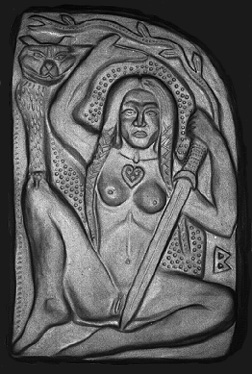
Original sculpture by Markus Wolff available for purchase
Norse God Odin Was a Real King, Explorer Says
December 3, 2001 OSLO -- The Viking god Odin may have been a real king who lived in what is now southern Russia 2,000 years ago, Norwegian explorer
Thor Heyerdahl said in a controversial new book on Thursday.
In "The Hunt for Odin," Heyerdahl says his archaeological
digs by the Sea of Azov in Russia backed evidence in 13th century sagas written by Snorre Sturlason that Odin was more than
a myth.
Heyerdahl, who won worldwide acclaim with his 1947 voyage across the Pacific on the Kon-Tiki balsa raft, said
Odin was a king who lived around Azov before being driven out by the Romans and taking his followers to Sweden.
Ancient
metal belt holders, rings and armbands dating from 100-200 AD found in excavations around the mouth of the Don River were
almost identical to Viking equivalents found in Gotland, Sweden, some 800 years later, he said.
"Snorre didn't sit
down and dream this all up," Heyerdahl told a news conference to launch his latest book with co-author Per Lillestrom. "In
ancient times, people treated Gods and Kings as one and the same thing."
Snorre's stories about Odin, viewed as the
king of the gods in Norse mythology, portrayed him as fighting battles. By contrast, Snorre treated Thor, the god of thunder,
as a mythical hammer-wielding figure riding through the air.
And he said that many of the place names in Snorre's sagas
matched the ancient Greek names for places around the Sea of Azov, such as Tanais.
Heyerdahl's digs with a team of
Scandinavian and Russian archaeologists uncovered skeletons and ancient metal objects.
"It's obvious that there was
some link between the Nordic region and where we dug," he said.
Some Norwegian historians have criticized Heyerdahl's
findings as based on insufficient evidence, saying that Odin's name originated from the Germanic name Wotan.
One likened
Heyerdahl's quest for Odin to digging for the Garden of Eden.
Heyerdahl, who exploits also included risking his life
on the Ra reed vessels crossing the Atlantic to show that the ancient Egyptians could have done so, said he doubted that the
book would silence skeptics.
"I don't think so," he said.
-- By Alister Doyle for Reuters
Alberich the Dwarf King
Alberich is the Dwarf King of Scandiavian faery lore. He is also known
by the name Alferich. His brother is Goldemar, the King of the evil and malicious Black Dwarfs.
King Alberich has his
home in an underground castle. This castle houses a weath of treasure beyond human imaging. His castle is even decorated with
large, magnificent gems.
Alberich is very important to the Scandinavian Gods. He has created many wonderful items and
gifts for the Gods.
The Dwarf King himself has several magikal items. He wears a belt of strength. He has a cloak
that can make him invisible. Balmung is an invincible sword of unknown metals. He also has a magic ring.
Alberich is
not known to keep company with humans.
-- Source: Daily Fairy Lore written by Lady Domnu
|
 |
|
|
|
 |
|
Page Contents:
- Groups that Worships Norse Gods to Become Officially Accepted
Religious Community
- The Asatru Moral Code: The Task of the Warrior
- Denmark to Accept Norse God Marriages
- Heathen Blots and Holidays
- Feast Days Honoring the Birth of Freyja: December
27 - January 10
- Midwinterblot January 13
- Thorrablottar January 19 - 20
- Yngona's Day January 21
- Old Disting January 25
- Fjortende Februar February 14
- Sommarsblot March 23 - April 14
- Festival of the Midnight Sun May 14
- Whitsunday June 11
- Feast of Sunna July 8
- Odin's Ordeal August 17-25
- Frey Faxi August 28
- The Festival of Urda August 29
- Leif Ericson Day October 9
- The Feast of the Fallen November 11
- Day of Ydalir November 22
- Wayland's Day November 23
- Day of Remembrance for Svyatagor the Bogatyr December 3
- Yule December 21
- Modresnach Decmeber 24-31
- 12th Night December 31
- Pagans and War
- Asatru in Argentina
- Norse God Odin was a Real King, Explorer Says
- Alberich the Dwarf King
- Other Resources
Heathen Blots and Holidays
Twelfth Night December 31
This is the last day of the 12 days of Yule. Fires are put out and the
feasting is over. It is an old custom to pull out a piece of the Yule log to light next year's Yule log with. New Year's resolutions
have evolved from the custom of making oaths on Thor's Hammers or Freya's cats.
Midwinterblot January 13
Midwinterblot was Christianized to honor St. Knut. Also called Little
Christmas, 20th Day, or Tyvendedagen. This midwinter celebrated honored Tiu, the chief God of the old Norse (predating
Odin), and ruler of the year. Norwegians greet each other with "Glaedelig Jul" to this day. Friends and families gather together
to take down their Yule trees, removing the decorations layer by layer, until finally the trees are hauled off with cheerful
merrymaking to be chopped up for bonfires and firewood. The last candies, cookies, and edible leftovers from the Yule
holidays are eaten as the celebrants honor their God by partaking in these last offerings of the holidays of darkness. It
is believed that the word 'Knut' is derived from the ruler Canute the Great, whose laws were recording during the period of
1017-1035, including the decree that there should be no fasting during the period between Christmas and the Epiphany. In Urnasch,
Switzerland, they celebrate St. Silvester's Day instead. Villages traditionally continue their New Year's celebration with
clanging bells to drive away the dark evil spirits.
Thorrablottar January 19-20
This holiday began the Old Norse month of Snorri. It is sacred to Thor,
and the ancient Icelandic Winter spirit, Thorri. The Thorrablottar is still celebrated in Iceland as Husband's Day with parties
and a mid-winter feast. This is a sister-festival to the Midwinter blot for Icelandic-Norse Asatruar, when women
are honored. During this holiday, women celebrate men, and wives honor their husbands.
Yngona's Day January 21
In Denmark, this day is a day sacred to the Danish Goddess Yngona.
Old Disting January 25
A feast day honoring the Disir, believed by some to be the Valkyries.
Feasting took place to honor the Disir, who were part of the Norse pantheon, who, like the Valkyries, serve to protect
people, and are caretakers of the land. The Disir are rarely present in the world of mankind, but appear
only at times of turmoil and great need. Freyja, who was honored earlier this month, leads them as the leader of the
Valkyries. The Valkyries, wage war on whatever is causing turmoil on earth. The runic half-month of Pertho ends today as well.
February 14: Fjortende Februar
This date is sacred to the Norse deity Vali, the archer God and
son of Odin. In modern Denmark, 'Fjortende Februar' (14th of February) is now celebrated as Valentine's day. Tokens
and gifts are exchanged between Danish schoolchildren, and Cupid's arrows are loosed by Vali.
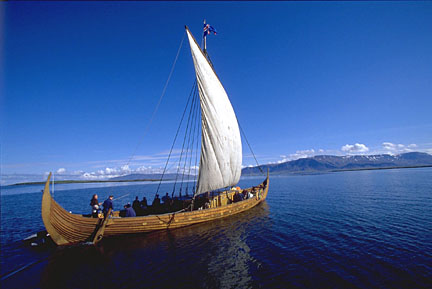
April 14th: Sommarsblot
The festival to welcome Summer. The Norse calendar was divided simply
in two seasons: summer and winter. At the time around the Christian Easter, which similarly is celebrated according to the
lunar calendar, this holiday is also called the Summer Finding, and may be celebrated as early as March 23. It is the day
the light of the sun overpowers the darkness.
Festival of the Midnight Sun: May 14
Peoples of the far northern section of Norway celebrate the Festival
of the Midnight Sun in honor of Sunna, the Norse Goddess of the Sun. The festival begins at sunrise and marks the beginning
of ten consecutive weeks without night.
Whitsunday June 11
Sacred to the Goddess Frigg, wife of Odin, honored as the Queen of Heaven.
Decorating nests and mazes represented the power of feminine love.
Feast of Sunna July 8
These festivities honor the Norse Sun goddess, Sunna, or Sol.
Sunna is pulled in her orbit around the earth by the horses Alsvid (all swift) and Arvak (early riser). The
wolf, Skoll, who will one day devour the world, pursues Sunna all during the day, trying to capture her and eat her.
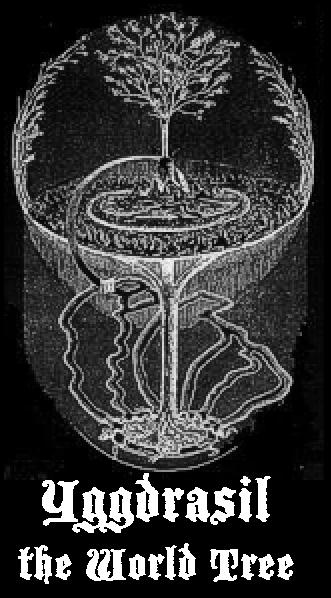
Odin's
Ordeal August 17 - 25
Also called Othin, Wotan,
and Wodin, he was the Nordic and Germanic all-father. He was one of the three original Aesir gods who created the world, and
most important of all the Norse Gods. He ruled over the Valkyries and rewarded slain heroes with glorious afterlife in the
Hall of Valhalla, where warrior spirits wait in readiness to defend Asgard against the Jotuns and Frost Giants at the foretold
battle of Ragnarokk.
Odin had an unquenchable hunger for knowledge and made great self-sacrifices to obtain
it. He once pierced himself with his own spear, and hung for 9 days on the world tree, Yggdrasill, to gain knowledge through
communication with the dead. On these days in August, his ordeal is commemorated. In special commoration of the final
day is the Festival of the Discovery of the Runes, when Odin fell screaming from the tree on which he had been bound, having
gained the knowledge he sought.
Odin's story has obvious
parallels to the story of Jesus Christ. He is loved as the all-father because, like a father, he reliably cared about mankind
and helped us, unlike most other gods worshipped by other cultures during those times. Like Christ, he also sacrificed
himself to death in order to share life-giving knowledge with us.
His story is also similar
to the story of Siddhartha, who achieved enlightenment and became the Buddha through an extended period of sitting beneath
a monkey-puzzle tree in meditation.
From the Viking age,
Odin survived the Christianization of Europe. He is still remembered, despite a period when even saying his name was banned
by the Church. Uppsala, Sweden, once observed this festival by sacrificing men and animals and hanging them in
trees; devotees were burnt on pyres.
Odin's symbol is the
valknut knot, his animal is the raven, his weapon is a rune-carved spear. We honor him every week with Wednesday, the day
named for him in our language.
August 28th: Frey Faxi
Norse harvest festival honoring Frey, god of the farmer, the harvest,
and fertility, and his horse, Blodughofi (Bloody-Hooved). Frey's horse, sometimes known as Freyfaxi, can race across
fire and air, symbolized virility and fertility. In ancient times, people held ceremonial horse fights in Frey's honor as
part of their celebrations. The celebration invokes the protection of all the gods and goddesses over the fruits of the harvest
during the coming darker half of the year, but especially honors Frey, god of the green months of spring and summer, god of
sunshine. This festival also honors horses, the work beasts, who helped bring the harvest in.
August 29th: The Festival of Urda
A feast day honoring Urda, the eldest and most-high of the three Norns.
Urda is who our Mother Earth is named for. She, along with her sisters, were older and had power over every other god. They
lived in a cave at the source of the Fountain of Life, the Urdabrunnr, at the roots of the World Tree, Yggdrasl. The Runic
half-month of Rad begins. Rad represents harnessing energy toward a desired end.
October 9: Leif Ericson Day
A Heathen poke at the US holiday of Columbus Day, since it has now been
proven that Norsemen 'discovered' the "New World" first...
| The knot of the fallen (chosen) ones belongs to |
|
|
| Odin, and is a protector, invoking power of eternal unity. |
November 11th: Feast of the Fallen
On this Celtic-Christian holiday of Matinmas, Asatruar and Norse Pagans
celebrate Einherjar, the Feast of the Fallen, or the Day of the Heroes. The Gods and those who have fallen in battle and joined Odin's warriors in Valhalla are honored on this day with feasting and merrymaking.
Slavic Pagans celebrate a Day of Remembrance for the Volhvs.
"At the time of Gleb Svatsolavich, a Volhv appeared...who went unto the
people and told his story. ...A rebellion of great proportions occurred in the town, and the people were set on killing the
bishop. The
townspeople became divided: Knjaz Gleb and his consort sided with the bishop, but all the townspeople sided
with the Volhv." -- Tale of Years Past
The great rebellion in all the High Volga Region occured in Susdal in
the year 1024. In 1071, two Wizards gave orders to the vast area from the Volga. 'In the year 6735, (1227 C.E.), four Volhvs
were immolated for their conjuring and working of magic. Believers in "God" did this! They were all burned in Jaroslav's
Court' (First Novgordian Epistle). Tip the horn in remembrance of those who died at the Christians' "virtuous" hands.
Day of Ydalir November
22
Feasting honors the god of archery and skiing.
Wayland's Day November 23
Sacred to
the God Wayland, or V÷lundr, the smith of the gods, who is credited by some as having crafted the sword Excalibur for the
Celtic peoples. This day celebrates the spirit of the Norse god of metalworking who is the patron of blacksmiths
and jewelry makers alike. Bless all your jewelry today or consider leaving it out in the moonlight all night to purify it,
especially if it is silver. Take an especially favorite piece of jewelry out today, wear it but also take a good look at it's
craftsmanship too. (Source: Fennian Moon)
Day of Remembrance of Svyatogor - December 3
Studen (December) 3 is observed as a day of remembrance for Svyatogor the Bogatyr, or "Holy Warrior" of Russian and Slavic Heathens. This day
is held to be the anniversary of the first battle with the Pechenegs, as well as the mystical discovery of the magickal coffin
at the Great Barrow Gulbishe in which Svyatogor became entombed. This great noble warrior has long been held in high esteem, perhaps a historical figure as well as a giant of legend. He was a giant, and his implements and armor were twice as large in
size as those of ordinary men. Drink a toast to this great warrior of old on this day.
Modresnach December 24-31
This is one of the most important Norse holidays, held at the time of
the Winter Solstice Modrescnach, or Modranect means "Night of the Mother" in old Saxon. The Saxons devoted
the following day to the Goddess as the Sea Mother, and an image of the goddess was launched out to sea.
During these cold winter nights and days, "The Great Mother" and all
the Gods are honored by drinking a toast to them and burning bonfires deep within the forest,singing from house to house,
bemasked and dancing. Some say that the Norse began the custom of decorating Christmas trees at this time, when they went out
into the forest and add brightly colored decorations to the trees.
In Finland, folklore says that the ghosts of departed loved ones
return home each year on this night. Many still light white candles on the graves of their loved ones on this night. Dreams are considered to have prophetic powers on this night.
The Slavs sing songs for Lada and of praise to Perun who are prisoner now under frost and snow.
They celebrate a week-long festival called Kolada Studen from December 24-31. The night of mothering has become connected
with the Virgin Mary. More:
Yule December 21
Yule is the most important holiday of the year. The night of Yule
was the night of Woden's Jagd, the Wild Hunt of the gods, when Odin would lead a band of gods, ghostly
warriors, and baying hounds through the night, hunting the meat for the Yuletide feast.
Children would leave hay out on this night for Sleipnir, Odin's 8-legged
horse. There would be a Yule cake and much feasting and gift-giving during this time. The swearing of Yuletide oaths is the
most solemn of Yuletide customs.
The word Yule means 'Yoke of the Year', from the Norse Iul,
meaning 'wheel'. During this period when there is almost no sunlight at all, Norse people were anxious for the wheel of the
year to continue to roll into the months of longer days and warmth. The Yule festival is long and includes many smaller festivals
and commemorations of different gods and goddesses. It traditionally lasts 12 days or longer.
While the rebirth of Frey, the god of fertility and farming, was principally
celebrated, many other gods and goddesses were honored. Some believe that it is Baldur who is reborn through reincarnation
on this day. Thor receives thanks as the defender of the world from the Frost Giants and Jotuns who roamed the earth
and tormented mankind during the winter months. His battles drive off these creatures and allow spring to return.
Frey's wife, Gerd, was one of these Frost Giants, and the story of how
he wooed her is allegorical of how Frey brings back the summer sun by capturing the heart of a daughter of ice and snow. Sunna,
the sun goddess, is also honored at Yule.
Many ancient symbols of Yule have survived, such as decorating with evergreen,
holly, and mistletoe, Evergreens remain verdant and alive during this time of year when everything seems dead; the weaving
evergreen boughs into a wreath is a powerful symbolism of the survival of the sun through the wheel of the year.
Yule logs and candles were lit, often by the youngest child in the household,
as a rite to welcome to warmth and light of spring. The Yule log was a huge piece of wood that was meant to be kept burning
throughout the twelve days of festivities; it is customarily lit with a piece of the Yule log from last year's celebrations.
Feast Days Honoring the Birth of Freyja: December 27 - January
10
Days of feasting and rites honor the birth and generosity of Freyja
(Frigg), the Nordic Mother Goddess. She is the much-adored goddess of love and fertility, crops and birth, and has a special affinity for the elves. January
7th is St. Distaff's day in the Christian calendar; Frigg's symbol is the distaff. Alternately, January 7th is celebrated
as Plough Monday, the day farmers return to work. The timing of this holiday is exactly on the first Monday after the
12 days of Yule. Farming implements repaired and blessed.
| The Fellowship of Earth, Moon, and Sky |
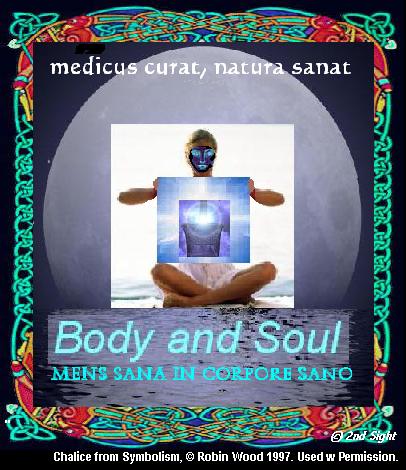
|
| Welcome and Mission Statement |
More Seasons, Festivals, and Lore
|
 |
|
|
|
